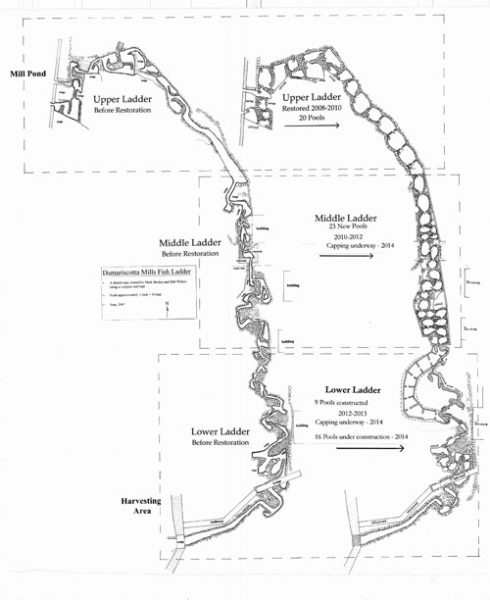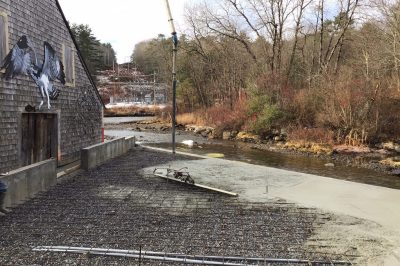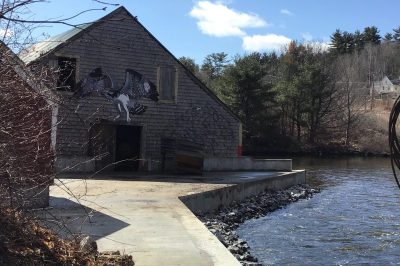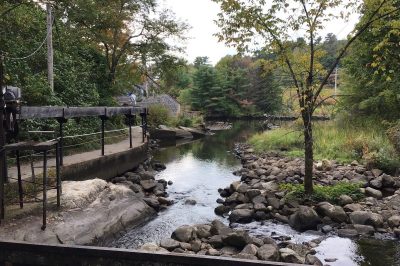Before the Restoration
The Damariscotta Mills Fish Ladder, mandated by the state legislature in 1795, was finally constructed by the Towns of Nobleboro and Newcastle in 1807. Mills had blocked the passage of alewives to their freshwater spawning grounds in Damariscotta Lake since the early 1700s. The Towns abutted the fresh water falls and they jointly held the right to harvest alewives below the falls. Together, the Towns were also responsible for maintaining the stone fish ladder. Thus, during the next 200 years, the Towns of Nobleboro and Newcastle repaired and re-built sections of the fish ladder on numerous occasions, as constant use and weathering took their toll. By 2006, the stone structure was in very poor condition and long-time harvester, Frank Waltz, struggled to modify areas where stone walls had collapsed or the rise between pools was too steep for adequate passage. Frank shared his concerns with neighbors and friends of the fish ladder, thus setting in motion the Damariscotta Mills Fish Ladder Restoration.
Restoration
In 2007, a community group, in collaboration with the Towns and the Nobleboro Historical Society, made plans to address the five most deteriorated sections of the fish ladder. These sections included: 1) A wall that had collapsed just above the footbridge near the bottom of the fish ladder; 2) a section in the middle of the fish ladder where concrete walls had been poured to “fix” a particularly challenging section; 3) an area called “behind Buzzells” where the ledge was especially steep; 4) the pools in the upper third of the fish ladder, many of which were leaking, collapsing, and otherwise not working, and finally; 5) the top three pools in the fish ladder, where the fish wouldn’t congregate for reasons unknown.
In support of these efforts, a design team including, from US Fish and Wildlife Service, fishway engineer Curtis Orvis and Fred Seavey, and, from the Maine Department of Marine Resources, Gail Wipplehauser, offered their services. After visiting the fish ladder on numerous occasions, these professionals provided plans to modify the fish ladder from the inconsistent, mixed-design structure that it was into a classic pool and weir fishway.
The initial estimate for the reconstruction of the five most deteriorated sections of the fish ladder was $30,000. With this optimistic estimate in hand, work began during the summer of 2007on the 34’-long-wall that had collapsed into the main channel of the fish ladder. The work was completed in late fall, 2007 for a cost of $30,000 for this section alone.
The Upper Third (2008 – 2010)
Fundraising for the upper third of the fish ladder began in earnest in 2008, with both spring and fall festivals as well as a late winter bean supper. The first grants were also written and work began on the upper third of the fish ladder during the late summer and fall. Once the work began, it quickly became apparent that many of the pools needed to be completely re-built rather than modified. The race was on each season because the fish ladder was in use for fish passage between April 1 and November 30. So, the restoration work could only be carried out between December 1 and early to mid-April (the latter with permission from the MDMR). It took approximately $250,000 to re-build the upper third of the fish ladder but the pay-off was immediate. In 2007, before the restoration began, we passed 80,142 alewives into Damarisotta Lake. In 2008, after fixing one collapsed wall and temporarily modifying many pools with the new pool and weir design, we passed 147,834 alewives into the lake and in 2009, when the upper ladder was nearly finished, we passed 382,422 into the lake. A total of 299,022 fish entered the lake in 2010.
The Middle Third (2010 – 2012)
We decided on a new approach for the middle third of the fish ladder—to remove the old structure and to pour concrete footings and pool walls in the first year and to stone face the pool walls during the following year. Oh, what a disaster this approach turned out to be! In the spring of 2011, the alewives came in and seemed to stop when they reached the concrete pools. Many modifications were made during the upstream run to convince the fish to make their ascent but none of these methods was particularly successful. By the end of the 2011 run, only 63,036 alewives had passed through the concrete pools and up the ladder to spawn. This was a terrifying experience right in the middle of the restoration project.
During the winter of 2011-2012, the pool walls and weir openings of 23 pools were faced with rounded cobbles. Oh, what a difference the stones made! During the spring of 2012 we had a banner run, passing 517,044 alewives in late April, May and early June. We had learned a huge lesson—the pools needed the cobble linings to dissipate the energy of water as it hit the pool walls!
The Lower Third-Upper (2012 – 2013)
Access to the bottom third of the fish ladder was really challenging so, in the fall of 2012, we constructed a solid bridge from a Ladd’s Hill Road driveway across the fish stream. The bridge allowed us to get equipment across to the other side, which was level enough to use for staging our operations. As we began work on the lower third of the ladder, we were faced with a real problem: the original course of the fish ladder ran along a stone house foundation. The ledge in the area formed an intractable V shape that many had tried to drill or jack hammer through the years. Since those days, the house had been given a real foundation so working on the ledge by this house was no longer an option. The solution? We blasted a new channel for the fish ladder to keep it away from the house foundation and it worked beautifully. We ended up with nine lovely new pools, stone faced before the 2013 fish run. And, we passed 912, 930 alewives that year.
The Lower Third – Lower (2013-2014)
We were exceptionally fortunate in 2013 because we received a number of large grants in addition to our fundraising from festivals and other community events. As a result, we were able to tackle the final or lowest sixteen pools during the winter of 2013 – 2014. The terrain was tough to access – the concrete guys had to lug their forms for quite a distance and the masons again worked under a large plastic tent heated by propane. Everyone working in the heated tents had cold feet—the propane-heated air rose while the mason’s feet were perpetually standing in cold mud).
By the spring of 2014, all of the pools were working as they were designed with stone lined interiors. And the fish came, and they came, and they came….a total of 1,066,314 alewives passed up the fish ladder that spring, a record!
Finishing Touches (2014 – 2017)
By spring, 2014, all the working parts of the fish ladder pools were complete, including both the concrete walls and the cobble lining. All that was left to complete the restoration was stonework and capping on some upper pool walls (lower ladder) and on the large retaining walls (in various locations throughout the fish ladder). This work was completed by 2017. The counts of alewives entering Damariscotta Lake to spawn just keep increasing although, just like in the “old days”, the counts vary in response to weather conditions, both natural and human predation, and many, many other factors.
Overall, the Damariscotta Mills Fish Ladder Restoration took approximately 10 years and about $1,000,000 to complete. and the help of so very many!
Beyond the Fish Ladder – Walkways and Bridges, the Fish House and Parking Lot, and More
The Restoration Committee has changed a bit through the years but it continues to be a vibrant group committed to seeing this wonderful neighborhood project through to the end. And, the big question, as always, is: what is the end? There are certainly plenty of projects: the fish house is in poor condition; the parking lot and the old concrete boundary at the water’s edge are collapsing; the bridges over the fish ladder are old and in need of repair or replacement; and all of the harvesting equipment needs to be replaced or repaired. And, if that’s not enough, a fund must be set aside for the upkeep of the fish ladder….in perpetuity.
The first project, replacement of a collapsing section of walkway between the fish house and the harvesting area, is underway as of the fall and early winter of 2019. We expect other projects to take place as funding is raised, with a priority for projects that make the infrastructure that relates to the fish ladder safe for use by all of us who love to visit. Thus, the earliest work will focus on walkways and bridges. In addition, the harvesting gear will be repaired and replaced, largely using funds derived from the harvest. All funds received from the harvest of alewives is split between the Towns of Nobleboro and Newcastle and placed in dedicated accounts for use to improve the facilities.
The drawing below shows the fish ladder layout before restoration on the left and the current status of the restoration on the right.

Restoration News
Help Us “Bridge the Gap!”
The viewing spot over the Fish Ladder never gets old, but the bridge has seen better days. Engineering studies are underway and we are asking you to partner with us to raise the funds needed to build a replacement. Click here for details.
Walkway Replacement Underway at Damariscotta Mills Fish Ladder
Click the post title for details about current work on the Fish Ladder.
Walkway Replacement - During & After







